
Western Influence on Malayalam Language and Literature
Book Specification
| Item Code: | IDD951 |
| Author: | K. M. George |
| Publisher: | Sahitya Akademi, Delhi |
| Language: | English |
| Edition: | 1998 |
| ISBN: | 8126004134 |
| Pages: | 301 |
| Cover: | Hardcover |
| Other Details | 8.9" X 5.6" |
| Weight | 440 gm |
Book Description
About The Book:
Its programme is directed to fostering and co-ordinating literary activities in the Indian languages - not by interfering with the writer's liberty of expression or presuming to guide or influence him, but by encouraging him to give his best and to make it available to readers in languages other than his own. Its publications are mainly in Indian languages. Though its publication programme in the English language is generally limited to supplying basic information about Indian writers and their works, Histories of Literatures and learned treatises are also published.
Dr. George's comprehensive study is thus valuable, not only for throwing a revealing light on the immediate subject, but also for its relevance to the subject, but also for its relevance to the wider subject of Western influence on India as a whole. It is only after inquiries have been conducted in depth, like Dr. George's covering the whole country and all the divers aspect of the problem that anything like a definitive picture for all India can be expected to emerge. But even by itself, Dr. George's study has an importance transcending Malayalam language and literature or the life and culture of the people of Kerala.'
Dr. K.M. George (b. 1914) is an eminent writer and editor in English and Malayalam. He taught Malayalam literature at Madras Christian College and has been a Visiting Professor at Chicago University and Indian Institute of Advanced Study, Shimla. He has been associated with Sahitya Akademi from its very inception and has been Vice-President of the Kerala Sahitya Akademi as well. His works have recived three literary awards. He is also a recipient of the Soviet Land Nehru Award, the Fellowship of the Kerala Sahitya Academy, and Padma Shri from the President of India. He was Chief Editor of Malayalam Encyclopaedia and Comparative Indian Literature. His major publications include: A Suruey of Malayalam Literature; Western Influence on Malayalam Language and Literature; American Life through Indian Eyes; Place-names of Southern India and A Many-branched Tree: Perspectives of Indian Literary Tradition.
MALAYALAM is the language of the people of Kerala, one of the nineteen States of the Indian Republic. Prior to Independence, the Malayalam-speaking region was composed of three units, the district of Malabar under the Madras Presidency and the two native states of Travancore and Cochin. In 1950, the two states were integrated under the name of Travancore-Cochin State, and in 1956 the whole of the Malayalam-speaking region became the State of Kerala as a result of the general reorganization of the states based on the major languages of the country. Kerala, though not conspicuous by its size or population, has been a focus of attention for political thinkers no: only of India but of the whole world, because of the revolutionary and challenging attitude of the progressive section of its population and its bewildering and tempestuous politics.
As a political entity Kerala is no doubt of recent origin, but as a geographical region it has an early reputation. As a matter of fact, no part of India has been so widely known to foreigners as Kerala. Even as early as the 3rd millennium B.C., "foreigners traded in spices with Kerala. In the days of King Solomor. (1000 B.C.) the ships of Tarshish used to visit this region to get ivory, apes, and peacocks. In the early centuries of the Christian era, Romans were attracted by its pepper produce. There is mention of Kerala in the Ramayana and the Mahabharata. There is also reference to it in Asoka's Rock Edict II (257 B.C.). Kerala had'con- tacts with the Arabs, the Assyrians, the Babylonians, the Greeks, the Romans and the Chinese as well. Thus Kerala has been well known from very ancient times, and it attracted foreigners from various far-off places even in such bygone ages.
Foreign contacts assumed a new significance with the coming (If the Portuguese under the leadership of Captain Vasco da Gama in 1498. His discovery of a new route to India was an event of tremendous importance as it brought India into intimate contact with a new type of civilization. Vasco da Gama landed at Kozhi- kode (also known as Calicut) on May 18, 1498. This discovery was one of mutual advantage to India and the West. The first among the Western nations to take advantage of it was Portugal itself, for Portugal had a long tradition of sturdy seamen who could brave the perils of maritime life.
The Portuguese maintained their contact with Kerala for over a century and a half. They found a hospitable shore in Kerala. Though they came merely as traders initially, the political con- dition of Kerala in those days was such as to kindle imperialistic ambitions in them. These led to the organization of a few colonies with a mixed population of Indians and Portuguese. Albuquerque, one of the viceroys of the king of Portugal, was the main architect of the scheme. He encouraged inter-marriage and employed Indians in the army. Colonies were set up in such places as Kodungalloor, Cannanore, Cochin and Quilon, all on the coast of Kerala. Out- side Kerala they set up forts in Goa, Diu, and Daman.
During this period some of the Indian rulers changed their methods of warfare and started to use fire-arms against their rivals, getting the wherewithal from the Portuguese.
The Portuguese introduced improved methods of cultivation to meet the increasing demand for coconuts and spices. They also introduced new produces such as tobacco and cashew trees. The foreign trade expanded considerably and helped to increase the overall prosperity of the local inhabitants.
The general appearance of the coastal cities also changed in due course. In Cochin, Calicut, and Quilon imposing buildings were constructed on European models. The impact of European civilization was felt to a recognizable extent. On the religious side also the Portuguese were alert. By conversion and inter marriage they managed to increase the Christian population. They set up educational institutions to impart religious knowledge and provided opportunities to study Latin and Portuguese. The Kerala Christians were brought under the authority of the Pope by the well-known Synod of Diampur, convened in 1599.
The Portuguese not only taught the local people European languages, but they learnt Malayalam for an effective dialogue with the people. Their trade and proselytizing programmes would not have advanced without a grasp of the local language. St. Francis Xavier, one of the most remarkable evangelists who came to India, translated into Malayalam portions of the Bible which were printed at Goa in 1557. He also compiled a Malayalam version of the catechism. This appears to have been the beginning of a move- ment of translation from foreign languages. A printing press was set up in Kerala as early as 1577, and the first book to be printed was Kristiya Vedopadesam (Doctrina Christiana-in Tamil. 1579). Some rulers, particularly those of Cochin, acquired proficiency in the Portuguese language and adopted it for diplomatic corres- pondence. But despite all this, the Portuguese influence on Indian Culture was not considerable.
Foreword
It is an honour, as it is also an embarrassment, to be asked to write a; Foreword to so scholarly a work as Dr. K. M. George’s Western Influence on Malayalam, covering ground that is to me both un-familiar and fascinating. Although my native District, Tirunelveli, borders on Kerala, and many of my relations know Malayalam and have lived for long periods in Kerala, the greater part of my own life has been spent in Karnatak and Andhra, and my remarks can have value only as those of an interested and friendly neighbour, if not ‘outsider’.
Dr. George has already placed scholars under his debt by , his earned memoir, ‘Ramacaritam’ and the Study of Early Malayalam, and his valuable Survey of Malayalam Literature; and he seems also to have won a niche for himself on the contemporary literary scene in Kerala, especially with his penetrating critical essays. Besides, his biographical and critical study of Kumaran Asan, which I have just read in manuscript, is to make a worthy addition to Sahitya Akademi’s Makers of Indian Literature Series’. His meritorious association with Sahitya Akademi, more particularly as Secretary, d' me Regional Once at; Madras, his Visiting Professorship at Chicago University, his contacts with scholars at East-West Centre, and his present assignment as Editor-in-Chief of the Encyclopedia have helped him to many fruitful en-counters and abundant experience, and all this is pressed into service in his ambitious and exciting attempt to assess the Western influence on Malayalam.
‘Western’, of course, is an omnibus term and comprises all the European. Nations and America too; and ‘Malayalam’, signifies, not merely the language and the literature, but the whole complex of race thought, religion, culture, artistic and literary expression, economics, social tensions and social change, and the yet more or less irresistible movement towards the future ’ is the language of the people, now numbering nearly 20 millions, living in the region between the Western Ghats and the Arabian sea in South India. Till about a millennium ago, Old Tamil (or Sen Tamil) was the language of this Dravidian region also, doubtless with distinctive dialectica variations reflected in popular Boating songs and ballads. Ilango Adigal, author of the old Tamil classic, Silappadhikaram, was a Chera (or we might say, Kerala) Prince : another early poem of the Sangam Age was in praise of Cheran Senguttuvan, the greatest of the Chera Kings: and Kulasekhara, hailing from this region, is celebrated as one of the Tamil Vaishnava hymnists. Indeed, the filiations between Kerala and Tamil Nad being rooted in history have happily persisted in later times, and the great Sri Narayana Guru himself composed hymns, not only in Malayalam and Sanskrit, but in Tamil as well.
The people of this colourful and romantic region, once they grew conscious of their distinctness from the neighbouring Tamils, continued for a time susceptible to Tamil influence, and then, with the coming of the Aryan Nambudiris, to the influence of Sanskrit. The arrival of Christianity and Islam was another disturbing, if also creative, force, and the impact of the languages and culture of the European maritime powers—the Portuguese, the Dutch, the French, the British—was the Hnal fateful twitch of the thread Malayalam language and literature and the culture of the Kerala region are thus a variegated and many-hued tapestry still in a process of purposive unfolding.
In the early centuries of Malayalam’s distinctive career, Tamil influence continued in Court and Letters, and from this partnership of convenience between Malayalam and Tamil originated the song- mould Pattu, of which the most illustrious among the survivors is Cheeraman’s Ramacaritam. The Aryan impact had in the mean- time brought Sanskrit upon the scene, and out of the not unwilling marriage of Malayalam and Sanskrit arose manipravala (ruby and coral). Of deeper import still, like an underground river, there ran the limpid flow of native song attuned to the genius of the people. ‘ This Triveni (triple stream),’ says Dr. George, ‘ flows on from the twelfth till about the fifteenth century when the Tamil stream gives away; but the Sanskrit stream goes on ....’ From the 16th century onwards, the breezes from the West began blowing ion Kerala lowlands and highlands alike, bringing with them a disturbing yet tonic freshness and vitality. It was in the 16th century too that Ezhuthachan occurred whose Adhyatma Ramayana and Mahabharata have proved to be veritable Springs of Helicon to all subsequent Malayalam poetry. Whether in respect of this seminal relationship to the Ramayana and the Mahabharata and the other classics of Sanskrit or in respect of the response to the many-faceted Western impact since the 16th century, Malayalam language and literature—like other Indian languages and literatures—has followed roughly the same course of evolution from the old to the new, from the classical to the modern. It is no wonder, then, that the main conclusions of an inquiry into the Western Influence on Malayalam are capable of application to many other Indian languages also, the differences being largely matters of chronology, emphasis and minutia:. Dr. George’s comprehensive study is thus valuable, not only for throwing a revealing light on the immediate subject, but also for its relevance to the wider subject of Western influence on India as a whole. An Indian reader, even when he is following Dr. George’s argument and massed information and informed criticism, will also mentally recall parallelisms or variations in his own language and literature, be it Tamil, Kannada, Marathi, Hindi or Bengali. In cooperative undertakings like Modern India and the West edited by L. S. S. O’Malley, scholars mainly Western have attempted to evaluate with some amplitude the Western influence on India, but it is only after inquiries have been conducted in depth like Dr. George’s covering the whole country and all the divers aspects of the problem, that anything like a definitive picture for all India can be expected to emerge. But even by itself, Dr. George’s study has an importance transcending Malayalam language and literature or the life and culture of the people of Kerala.
The influence of Sanskrit on Malayalam has been of much longer duration, and goes far deeper, than the influence of English or the West, but even so this too is of vast and varied significance, as is very well set forth in Dr. George’s present work of painstaking scholarship and research. He has arranged his immense mass of material under ‘Language’, ‘Literature’ (comprising both a chronological survey and a genre-by-genre discussion), and ‘The Cultural Aspect’ (almost a hold—all section), and he usually allows facts to speak for themselves instead of merely making sweeping gereralisations and expecting the reader to fish out for himself the illustrative material. On the whole, it is apparently much easier to farm an idea of the Western influence on the language than on the literature or culture of Kerala. Portuguese, Dutch and French him together to account for 200 word-borrowings, as against 4000 from English, even phrases and, idioms like ‘Alice in Wonderland•’ and ‘bolt from the blue’ easily acquiring a Malayalam habitation. .. The work of the Western lexicographers——notably Dr. Gundert a German missionary—and grammarians like Dr. Caldwell, author of the well-known comparative Grammar of the Dravidian languages was of course of outstanding merit, and helped Malayalam to awaken into its unique heritage and to start fulfilling its limitless possibilities. In literature, it was the Western missionary—and presently his native counterpart—who first stimulated prose writing through the establishment of printing presses and the publication of tracts and Bible translations. But after 1880, the movement gathered momentum slowly, and translations, adaptations and original compositions came out with increasing frequency and a growing sense of self-assurance and power. Translations and adaptations seem to have increased from 9 during 1880-1900 to as many as 447 during 1948-1966—almost 50% being from English, 25 % from Russian, and the rest from the other European languages.
In what is by far the longest Section—‘A Generic Survey ’— Dr. George has really given us, by sleight of hand as it were, a perceptive account of modern Malayalam literature. He takes us `briskly through the work of the novelists, the pioneering Appu Nedungadi, Chandu Menon, C. V. Raman Pillai and the realists and revolutionaries, Kesava Dev, Thagazhi, Basheer; and of the poets, the Asan-Vallathol-Ulloor trinity, and the masters Nalappat Narayana Menon, Sankara Kurup, Changampuzha and the rest. Western ‘influence’ on creative literature is not easy to locate or assess, but certainly there is a general climate, an ambience, in modem writing in Malayalam (as in other regional languages) that does reveal something of the distinctive Western ‘elan’. One senses it, although one cannot submit it to precise measurement or evaluation. ‘Forms’ and metres have doubtless been borrowed— themes too—and gestures and stances as well; above all, Western imagery—partly • Biblical, partly scientific and technological—has given a new tone and temper to modern Indian poetry, including poetry in Malayalam. In the result, modern creative writing in- Malayalam is full of adventure, experimentation and expectancy. And this has been sustained by a vigorous and varied background activity in the fields of literary criticism, journalism and other non-fiction prose. And thanks to the spread of literacy and the explosion of political consciousness in Kerala, the Malayalam press is, according to Dr. George, ‘probably the most virile and sensitive, as it now happens to be the intellectual cockpit of warring Western ideologies’. The last Section—‘The Cultural Aspect’—attempts the intriguing task of inferring the reciprocal influence of life and letters In Kerala in the general context of growing Western influence during the last three centuries. What has happened in Kerala is of course part of the larger national drama—the shock of the Western impact, the trauma of conquest, the first stirrings of the renaissance or New Life in the 19th century, the growing assertion of self respect and self-confidence in the 20th century, the coming of independence in 1947 and the recent frustrating experiments in reconstruction. The awakening in Kerala threw up, among others, the extraordinary socio-religious reformer Sri Narayana Guru, one of whose nearest disciples, Kumaran Asan, became in I0me respects the representative Malayalam poet of the modern period. Western influence has evidently seeped into every aspect of life, though not always for the better. And even after independence, the British influence has shown no signs of weakening. ‘Apart from Sanskrit,’ says Dr. George, ‘no other language his touched Malayalam as deeply and as effectively as English and yet Malayalam literature today seems to be less in shackles to foreign mores than ever before. It has arrived at maturity, and II poised for bold leaps forward. The writer not only enjoys an honourable status in Kerala, he is even reasonably recompensed for his work. The Sahitya Pravarthaka Co-operative Society-an extensive and flourishing organisation—offers it authors a royalty of 30%, the highest in the world. Like the ‘green revolution’ in Hariana and the Punjab, the ‘white revolution’ in Kerala is as sensational as it augurs well for the future of Malayalam literature.
Indian Literature is one, although it is written in several languages. ‘I am an Indian writer,’ says Umashankar Joshi, ‘though I happen to write .in Gujarati.’ So too might a Sankara Kurup, a Basheer or a Thagazhi truthfully a firm. Everywhere the sources of Inspiration are the same. the inducements, the challenges, the provocations, the saving graces have been the same: the deep springs within, the violent breezes without, the religious, political and social—economic currents have been more or less alike over the entire sub-continent. The hackneyed phrase ‘unity in diversity’ does nevertheless hit the truth of the unity of Indian literature and culture that is much more than the mere sum of the regional literatures and cultures. The appeal of Dr. George’s comprehensive and scholarly study will therefore be as much to the Malayalee as to the non-Malayalee reader: perhaps even more to the latter than to the former. By providing a pattern and also the necessary pointers, his study might help other scholars to undertake similar research-projects in respect of their own linguistic areas.
Preface
The unity of Indian culture is reflected in Indian literature which has a strong underlying oneness, although its outward expressions exhibit considerable variety and complexity through different languages and scripts. Two significant elements that we see in all modern Indian literatures are the deep and abiding influence of Sanskrit and the multi-faceted impact of the West. The influence of Sanskrit on modern Indian languages is clearly seen not only in the literary forms, but in phonology and vocabulary as well, whereas the Western influence is primarily limited to literature. The European spirit, through the English language, has revitalized Indian literatures increasing their range and utility.
Malayalam language and literature have been considerably indebted to Sanskrit and English. While the influence of Sanskrit goes to the very foundation of the language, that of English is seen only in the superstructure, mainly in the areas of modern literature. There are some studies which deal with the influence of Sanskrit on Malayalam; but very little has been written about the response of Malayalam to the Western impact. Therefore, considerable spade work had to be done on this fascinating subject.
Though Kerala had the benefit of foreign contacts even from pre-historic times, recognizable influence of such contacts can be traced only from the 16th century when the Portuguese first came to Kerala. After the Portuguese came the Dutch, the French and the British. Though we had contact with several European countries and many European languages and cultures, by and large, the English represented the West, and the impact of the West to a large extent was from English and through English. The term West, in this study, denotes not only the whole of Europe including the Soviet Union, but also America.
I have had the privilege of receiving a Fulbright Travel Grant when I accepted the assignment as Visiting Professor of Linguistics in the University of Chicago in the year 1964. This gave me a further privilege of receiving an Alumni Research Grant from the United States Educational Foundation in India during 1967. After some preliminary work on ‘The Impact of the West on Indian ‘literature’ as a whole, attention was focussed on Malayalam, the language of my specialization. Some important libraries had to be visited and discussions held with critics and scholars who were conversant with the subject. A questionnaire was prepared and sent to many writers to elicit their views on various related aspects. (When considerable progress was made in the collection of materials and marshalling of facts and figures, an invitation came from the East West Center, Hawaii, to spend ten months there in the capacity of a Senior Specialist. This was an excellent opportunity to further supplement the materials and write out the monograph. I left for Hawaii in October 1967 and within about six months I could complete the writing of the book. In the congenial and quiet atmosphere of the East West Center, located in the salubrious and enchanting island of Hawaii, the difficult work of writing a book became a pleasure. Let me take this opportunity to express my deep sense of gratitude to they authorities of the East West Center; in particular, to Dr. Minoru Shinoda, Director, Institute of Advanced Projects, and to Dr. Everett Klein-jans, Chancellor of the East West Center. I am also grateful to the USEF (India) for their Research Grant.
As the title indicates, the influence of the West, both on language and literature has been dealt with in this book. The study is divided into 4 parts: (i) Language, (ii) Literature—Chronological Survey, (iii) Literature—Generic Survey, and (iv) The Cultural `• Aspect. More space has been devoted for literature, and justifiably so. The approach has been analytical in the main. Being the first work of its kind, the attempt was to make. The study general and comprehensive rather than elaborate and in depth.
After going through the manuscript of the book, a non-Malayalee critic wondered whether modern Malayalam literature was a mere rehash of Western literature. When we concentrate, on the areas of influence, naturally enough other areas are pushed to the background. This is inevitable in a work of this kind which is not a history of literature. It is true that Malayalam literature has been considerably receptive to the best in Western literature as revealed from the themes and forms it has borrowed. But other Indian languages like Bengali, Marathi and Kannada have also been receptive more or less to the same degree. The West has influenced all our literatures directly and indirectly as a catalyst. Our aim is to assess the true nature and extent of this influence, which has been on the whole enriching.
It is always a difficult problem to indicate the correct pronunciation of Indian names in the English alphabet. The use of diacritical marks will considerably help; but for the average reader a profusion of such marks proves an irritant. In this work a compromise has been struck. The names of authors are given in conventional spelling, because they are fairly familiar throughout India. However, the names of books which are not so familiar are transliterated with some care, though even here strict accuracy is not claimed.
At various stages of this work, many people have helped me. Quite a few scholars and writers have been good enough to return the questionnaire sent to them with their remarks. Their number is so large that it is difficult to mention individual names here. Sri John Vergis Vilanilam has rendered very valuable assistance to me in collecting materials. I am obliged to Sri K. M. Govi of the National Library, Calcutta, who helped me considerably during my visits to the Library and later, particularly in the preparation of lists of books in Malayalam which have been translated or adapted from Western sources. I-am indebted to Mrs. Mariam Gould of the EWC for reading through the MS. and suggesting improvements. I am also indebted to Dr. K. Ayyappa Paniker, whose critical observations were very valuable, to Dr. Vellayani Arjunan who has helped me in compiling the lists of borrowed words from European languages and to Sri Chengarappalli Narayanan Potti for preparing the Index. Dr. P. K. Narayana Pillai, Dr. S. K. Nayar and Prof. S. Guptan Nair have gone through the manuscript and given useful suggestions. Among the non-Malayalee scholars who have gone through the manuscript and given valuable suggestions, the names of Prof. V. K. Gokak and Prof. R.—K. Dasgupta deserve special mention. To all these persons, I express my sincere thanks.
Dr. K. R. Srinivasa Iyengar, Vice-President of the Sahitya Academi and a well-known Professor of English and specialist in Indo-Anglian writing, has been kind enough to contribute a Foreword to this book. I am most grateful to him for the excellent Foreword which helps place the work in the correct perspective.
| CHAPTER | PAGE | |
| FOREWORD | v | |
| PREFACE | xi | |
| INTRODUCTION | 1 | |
| Part I: Language | ||
| CHAPTER I | Linguistic Aspects | 9 |
| CHAPTER II | Vocabulary and Idiom | 25 |
| CHAPTER III | Reference Books for Language Study | 34 |
| Part II : Literature - A Chronological Survey | ||
| CHAPTER IV | Background | 51 |
| CHAPTER V | Stage I - Early Influence (before 1840) | 56 |
| CHAPTER VI | StageII - The Influence Spreads (1840-1880) | 65 |
| CHAPTER V | Stage III - Increasing Impact (after 1880) | 73 |
| Part III: Literature - A Generic Survey | ||
| CHAPTER VIII | The Novel | 89 |
| CHAPTER IX | The Short Story | 107 |
| CHAPTER X | Poetry | 114 |
| CHAPTER XI | Drama | 146 |
| CHAPTER XII | Literary Criticism | 159 |
| CHAPTER XIII | Journalism | 178 |
| CHAPTER XIV | Other Prose Writing | 194 |
| | ||
| CHAPTER XV | Life and Letters | 217 |
| Appendix A, B, C, D | 247 | |
| Select Bibliography | 271 | |
| Index | 273 |
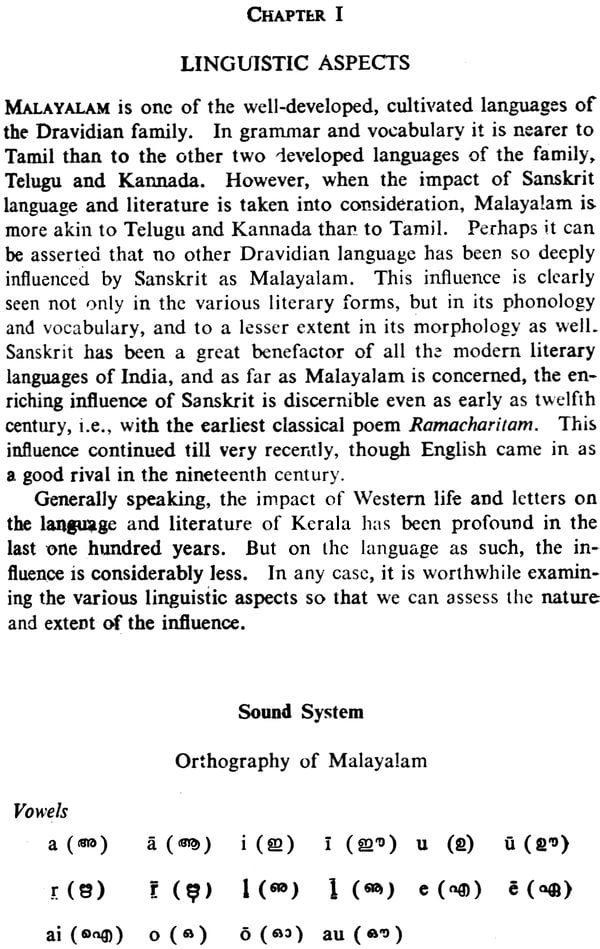


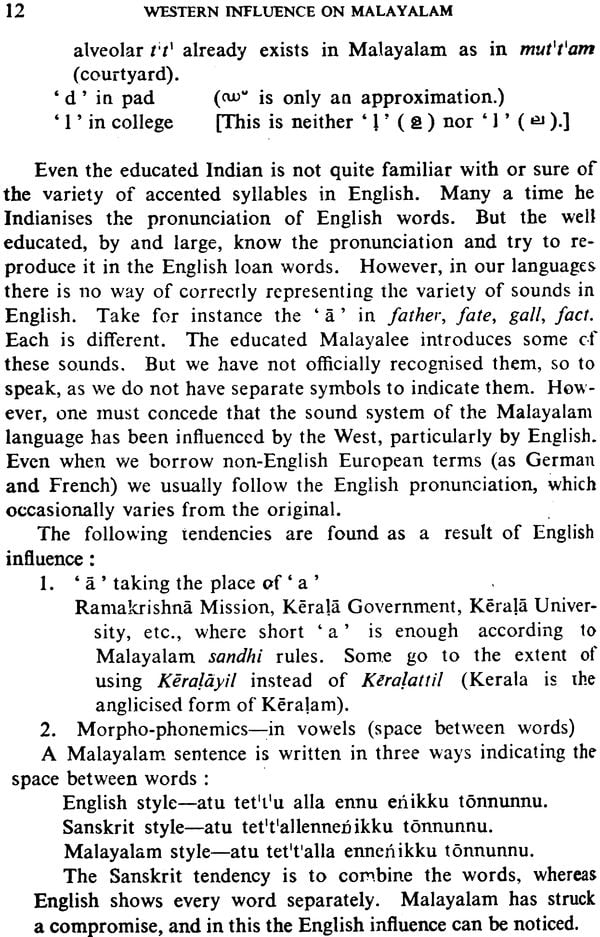


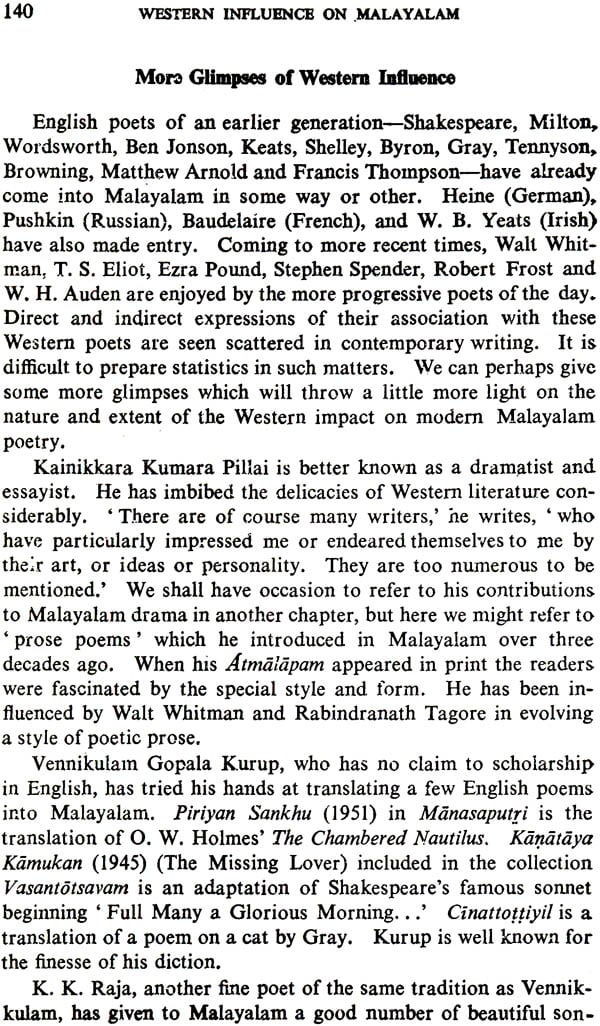
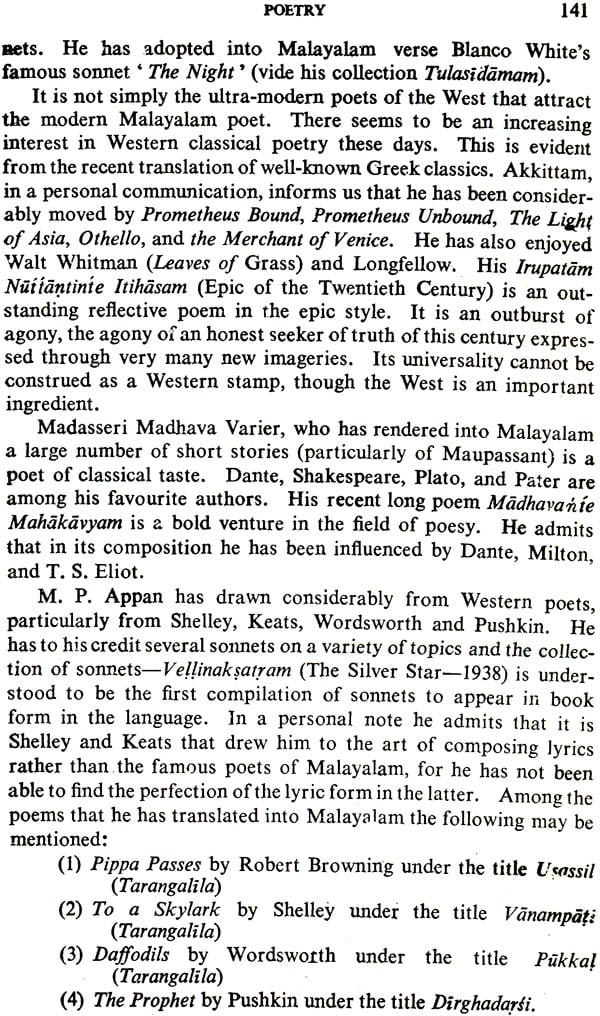
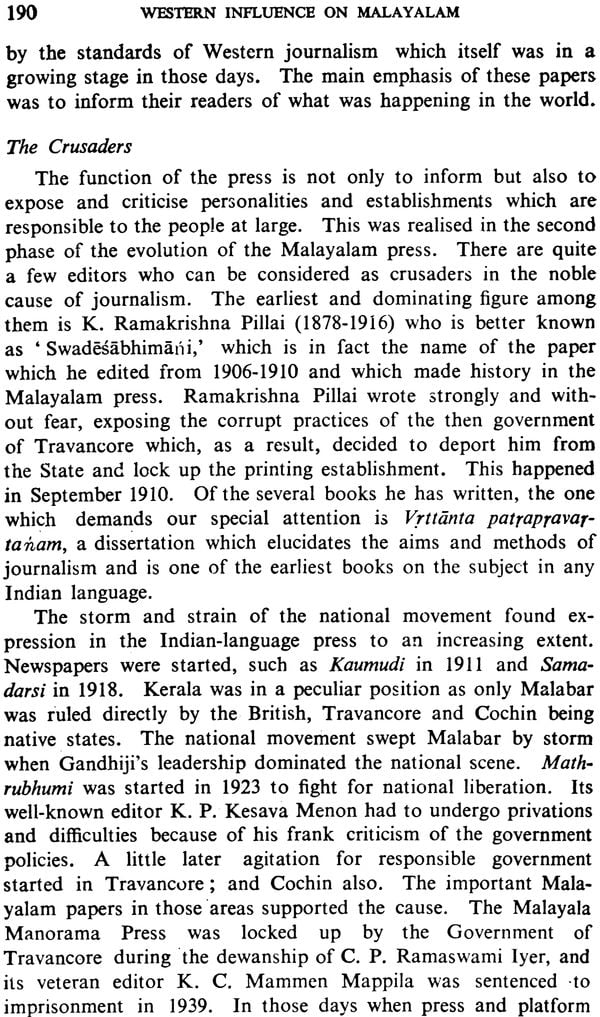
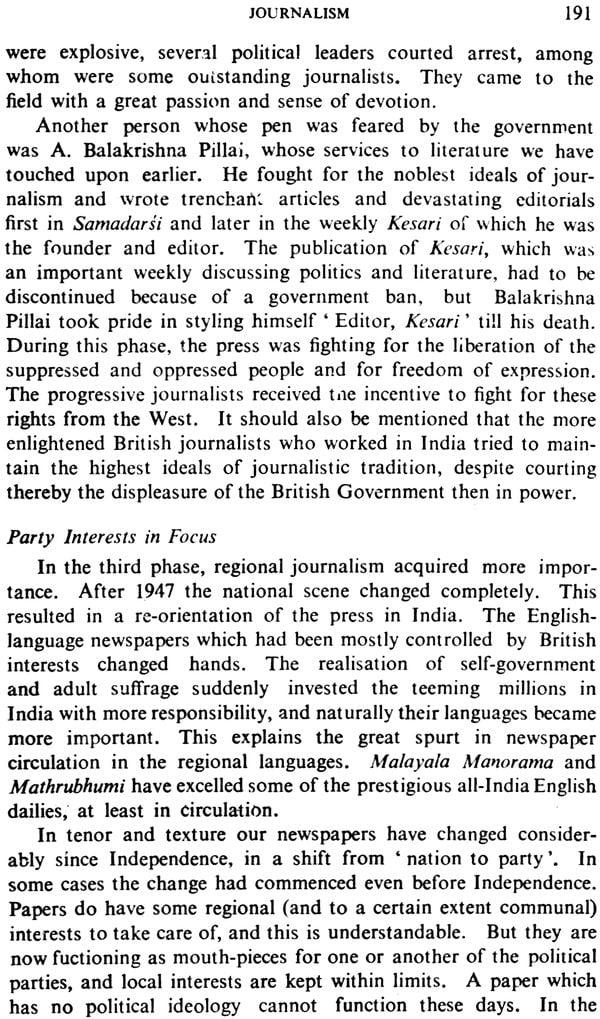



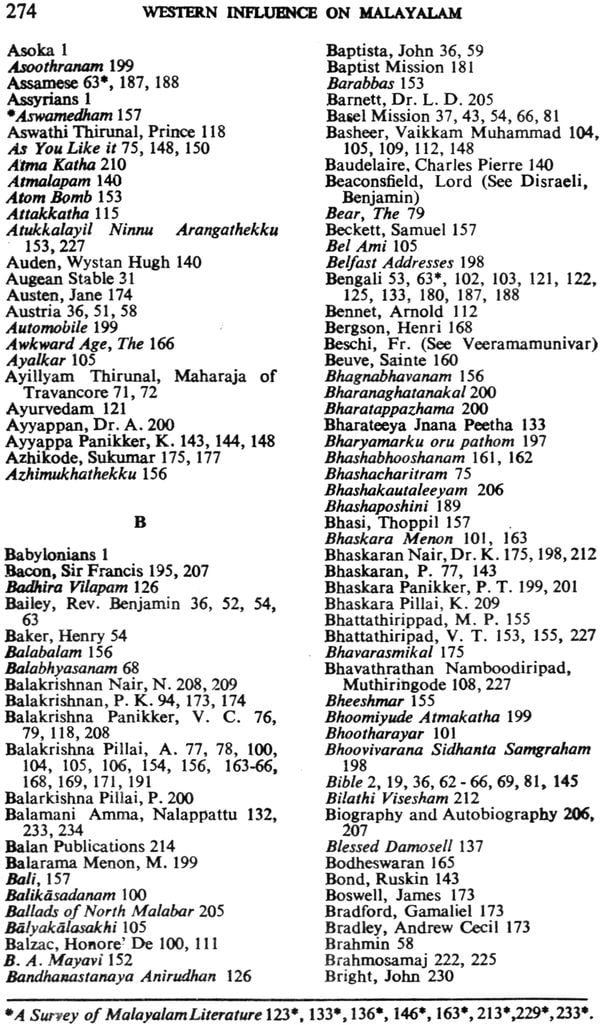
Click Here for More Books Published By Sahitya Akademi





